| 1 | Has rare horizontal pupils |
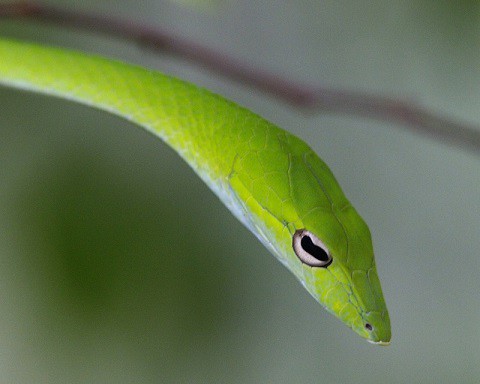
The vast majority of snake species in the world have either round, black pupils or vertical pupils like a crocodile. Round pupilled snakes are more likely to be diurnal (day-faring) while their vertical brethren tend to be nocturnal. But the Asian vine snake (Ahaetulla prasina) is in a category of its own, as its pupils are horizontal instead. They stretch from side to side in a thin line of intense blackness, and this is the norm within the genus of Ahaetulla that they belong to. This family has 18 members, and is the only family whose pupils are consistently horizontal.
The family has another rare eye feature as well – bincoular vision. This is the norm in humans, a field of 3D vision where the left and right eyes overlap to grant depth perception. It’s a skill we take for granted every day, but in snakes it’s very uncommon, as the two eyes are positioned on either side of the head in order to scan their environment for predators.
Consequently, the vision fields never overlap, but with the Asian vine snake, there are hollow grooves along their snout which give the line of sight room to cross over. This allows them to perceive distance and the true shape of objects (although they can’t zoom in like the name promises).
| 2 | A small, thin snake |
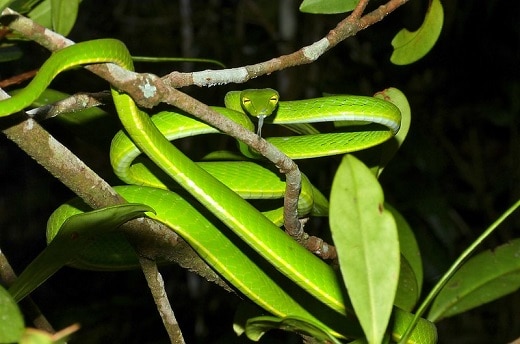
The Asian vine snake lives in the green forests of Asia and it looks like it’s absorbed the essence of those forests over the years. Its total body length is 1-1.5 metres, neither particularly short or long, but what stands out is its extremely weird body shape.
The Asian vine snake is as thin as a pencil, reaching peak thinness at a tiny neck which suddenly widens into the head. This head looks like the tip of a spear, with a long snout and the horizonal pupils angled towards the outstretched tongue to create an incredibly pointy appearance. The name of vine snake could just as easily refer to its plant-like appearance as its habit of living on vines.
The Asian vine snake is almost entirely green, in a bright fluorescent shade which extends to the head and even the tongue. The patterns are very subtle, in the form of fine darker green lines which can sometimes be blue. Its belly is yellow with green tinges, and its eyes are a fuller yellow, except for the pitch black pupils.
| 3 | Likes to give venom massages |
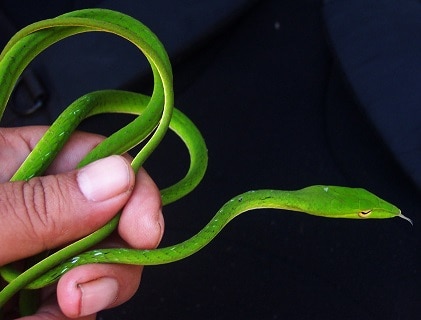
Asian vine snakes have venom glands, they have venom canals and they have venom, but the result is far too weak to kill a human being. It’s too weak to kill small animals in one bite as well. The Asian vine snake has a different strategy; they deliver a sharp initial bite, and spend the next 10-15 minutes chewing its prey repeatedly, to massage the venom into the wound. The snake needs to have its coils arranged to hold the prey in tight. If the prey escapes from its jaws then it could stagger off, seriously ill but able to recover.
On April 14th 2019, some researchers were wandering around a residential area of Aizawl, India, when they saw a relatively short 69cm Asian tree snake leap towards an Indian garden lizard (Calotes versicolor). The snake bit its neck, held it tight, and spent the next 10 minutes chewing the site of the strike. The lizard struggled but eventually stopped moving altogether.
At this signal, the snake rearranged its prey and swallowed it headfirst, while balanced carefully on a wooden fence. From bite to swallowing, the whole event took 25 minutes.
| 4 | Vine snake versus a gecko |
The Asian vine snake has a strange life, and things don’t always go according to plan. Biologists recorded another tale on October 2nd 2013, at 8:30am. It took place in the grounds of a hotel in Ubud Bali and began when the team noticed an Asian vine snake falling from mid-air with a flat-tailed house gecko in its clutches. The snake recovered quickly and started to drag its prey away, using its tail to pull itself backwards as it faced the researchers head on.
The duo travelled 1.5 metres across the stone pavement, 0.5 metres up a small wall, and then 1 metre across a flower bed. The lizard had already lost the use of its front and hind legs, and the Asian vine snake repeatedly chewed the lizard as it slowly and laboriously dragged it away.
It took 40 minutes for the gecko to become completely immobile. The snake then decided to swallow it headfirst, before heading up a tree with its tail first. But halfway up, things went wrong, and the snake suddenly regurgitated the lizard, having only managed to swallow the head. The snake disappeared up the tree, and its epic quest ended fruitlessly.
| 5 | A common star of snake wine |

It’s common to see Asian vine snakes on an Indian jungle trek, but a more convenient way to find one is to wander into a bustling Vietnamese tourist market. This species is one of the main snakes used to make the traditional beverage of snake wine. This reptilian juice is made with rice wine, and contains the snake’s bodily fluids, venom and all. It even contains the snake itself.
Most bottles contain an entire dead snake stuffed inside along with the bronze-orange liquid, to prove to tourists that it’s the real deal. The alcohol content nullifies the neurotoxins, hemotoxins, anticoagulants and all the rest, or so it’s said – dizziness and blood pressure falls are known to happen sometimes. In some bottles the snake is forced in alive, thrashing and biting, until it drowns and the “serpmentation” process begins. Many bottles have scorpions or centipedes shoved in as extras.
Snake wine was first invented by the Ancient Chinese circa 700BC and was believed to be widely invigorating. Today, it’s still a folk cure all, recommended for hair loss, arthritis, dry skin and far-sightedness.
Meanwhile, the mamushi snake of Japan is sometimes turned into ice cream.
| 6 | Widespread in southeast Asia |
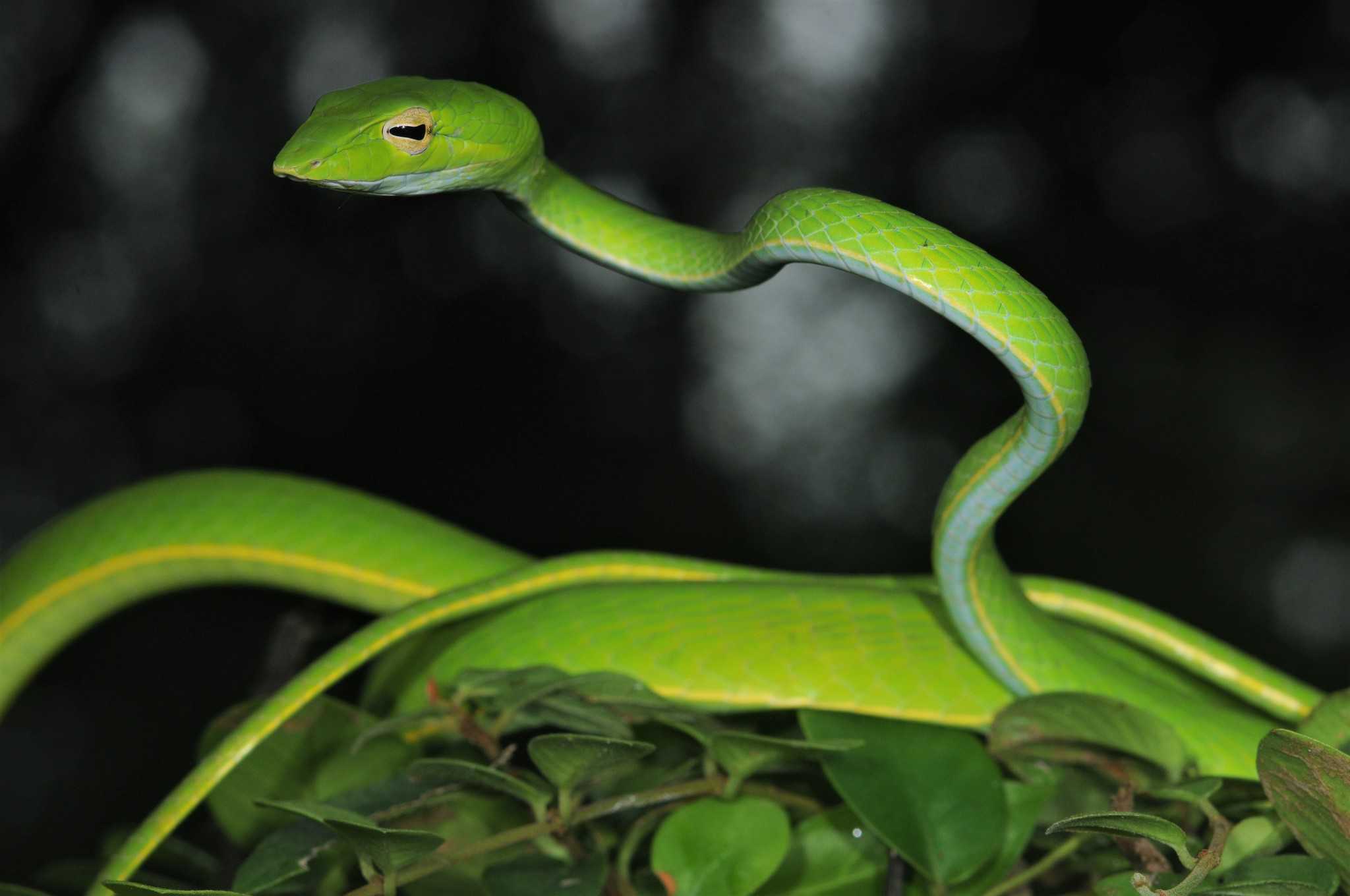
The Asian vine snake covers a large chunk of south-east Asia. It’s one of the most common of the Ahaetulla genus and can be found in India, Vietnam, Thailand, Indonesia, and Laos among others. There are none in Australia, the westernmost extent of the range is east India, and the northernmost extent is southern China.
As the name suggests, they’re most commonly found in tree branches disguised among the green foliage. This can be in richly forested habitats, but also the edges of fields, and on top of shrubs in agricultural farmland. They spend most of the day curled around branches in loops, and when night falls, they close their eyes and sleep in the same position.
But that said, they’re not as lazy as the branch-dwelling emerald tree boa of South America. It isn’t rare to see Asian tree vipers slithering along the ground in search for frogs or lizards as their prey. Their favourite forests are wet lowland forests, but they’re occasionally sighted at high altitude montane forest at up to 2100 metres.
| 7 | Mainly eats reptiles |
Lizards are the main staple of this snake, with frogs being a secondary dish and tree-dwelling mammals eaten only occasionally. For example, one incident above starred an Indian garden lizard (Calotes versicolor), a thin-bodied reptile which is equally common across south-east Asia. It’s around 30cm long including the tail, and therefore an easy meal to swallow whole. The males of this species have a bright red chest, while the females are a consistent pale green colour.
On December 1st 2017, scientists recorded another battle when an Asian vine snake measuring 1.1 metres was spotted on a fence in the Sungei Buloh Wetland Reserve in Singapore. It had a gecko halfway in its mouth, with the head nowhere to be seen and the feet and hind legs about to disappear.
It took 2 minutes for the gecko to disappear completely, and the species was determined as a common house gecko (Hemidactylus frenatus) by the spines on its tail. This gecko ranges from 7.5 to 15cm long, with a thick and stubby body. It also occupies a vast range in south-east Asia, but has a colony in northern Australia where they’re blissfully free from the vine snake terror (but maybe not other snakes).
| 8 | Offensive strategies |
When it’s time to hunt, the Asian vine snake shifts to a higher gear of camouflage. Relying on its green colour, it grips the branch with its tail and lowers the main bulk of its body slowly. Then it loosens its muscles and sways lightly in the wind, just like an actual vine. Only the ultimate herpetologist could spot this snake in the wild, and frogs and lizards don’t stand a chance.
Almost all snakes flick their tongues around to detect scents in the air, usually of prey (but maybe of hamburgers wafting around, who knows). The Asian vine snake even tones down this flicking, making just gentle movements. When it spots the frog or lizard creeping underfoot, it moves very slowly as it rearranges it coils into striking position.
When the moment for action comes, it always aims for the creature’s neck. Their binocular vision is a massive aid in judging the creature’s distance away, so that the strike doesn’t fall short or overshoot.
| 9 | They can vanish like magic |
The only way this snake could put you in hospital is if you didn’t have the heart to shake it off while it was chewing. The Asian tree snake isn’t particularly bold towards humans, and nearly always flees into the bushes. They’re a very fast snake, and when close to their branches and vines, they can move as freely and effortlessly as a human being walking down a pavement. As this video shows, they can soar up a branch as though walking on thin air, disappearing into the complexities of the tree in the blink of an eye.
If they do stick around, or if it’s facing a smaller predator, then they have a unique display of intimidation. The first, more common one is flattening out their neck like a cobra using unseen folds of scales, to make predators think they’re larger than they really are. The unique one is holding out their long green tongues and keeping them still. This posture is well known, but how it would intimidate a bird or larger snake, nobody is completely certain.
| 10 | Has a South American lookalike |
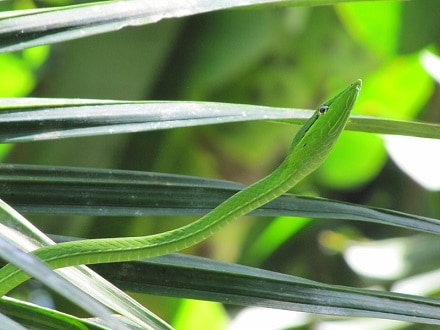
In nature, there’s a process called convergent evolution, where two unrelated species half away around the world look incredibly similar, due to identical environmental circumstances funnelling their evolution a certain way. One example is the Asian vine snake and its South American cousin the green vine snake (Oxybelis fulgidus).
These two share the ecological niche of thick green forests with plenty of vines to mimic, and consequently, the green vine snake is also a fluorescent green. It’s also thin and slender with an unusually pointy head, and it also swings from vines to catch prey scurrying beneath. Yet the green vine snake is part of the family Oxybelis, which likely diverged from Ahaetulla tens of millions of years ago.
There’s nowhere in the wild where these snakes co-exist, so there would never be a possibility of confusing them in the wild, unless you were locked inside the snake-infested labyrinth of a madman. But you don’t have to be a herpetologist to tell them apart. They’re extremely similar, but the horizontal pupils give the Asian version away every time. The green tree vipers have round, black pupils, and a more subtle difference is that their bellies are greener compared to the yellow-green of Asian tree vipers.